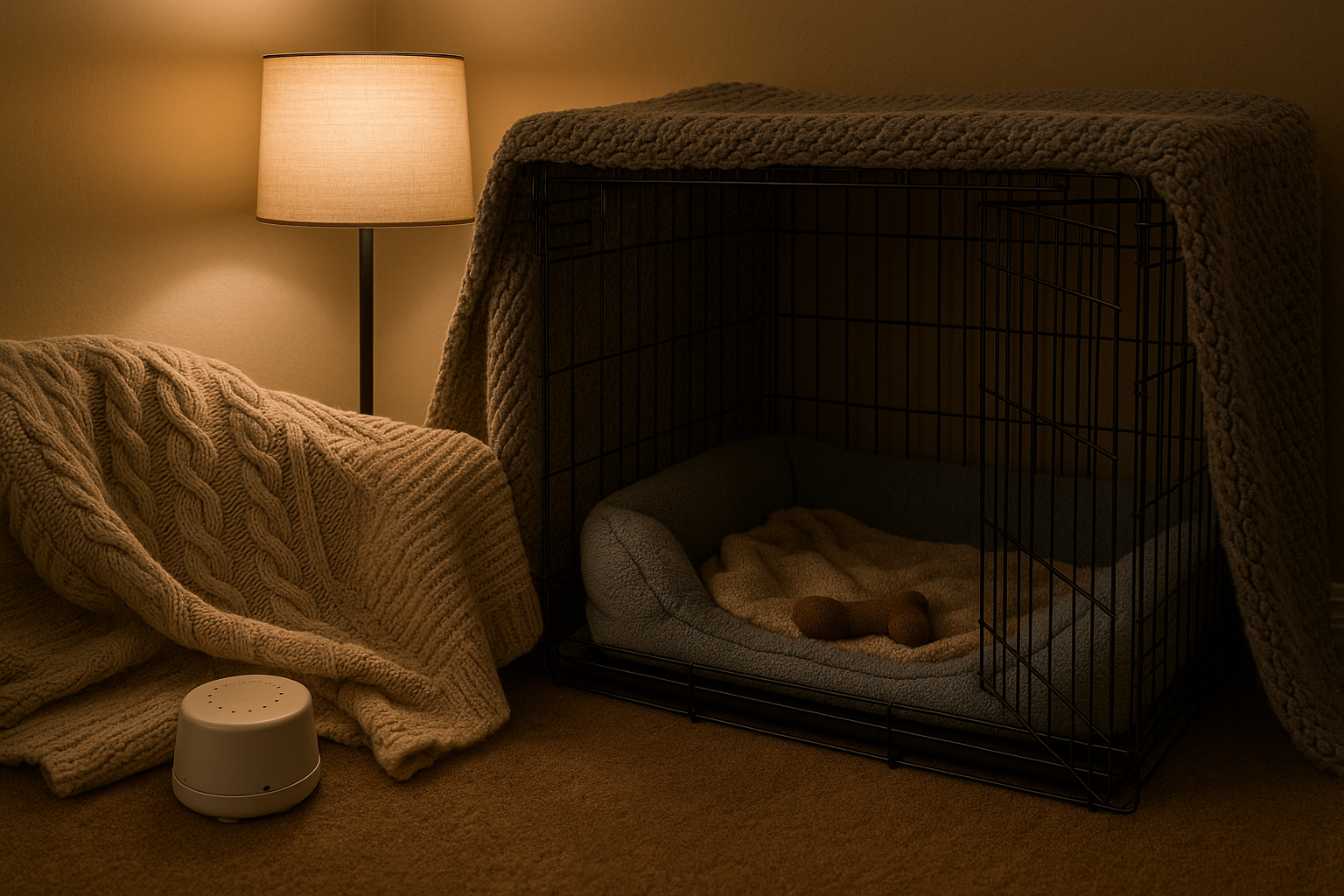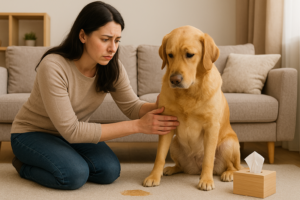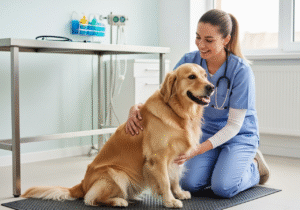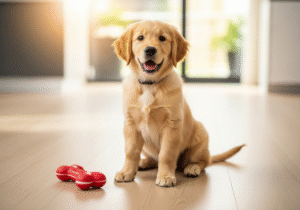Introduction
Dogs with noise phobia often react long before the sound fully arrives. It starts with a low rumble. Before the thunder even hits, your dog is already trembling, hiding under the couch, or trying to bolt out of the room. If this sounds familiar, you’re not alone. This condition involves a real and often debilitating fear of sounds like fireworks, thunderstorms, or even a dropped utensil on the floor. Studies suggest that up to 50% of pet dogs show signs of noise sensitivity or phobia, yet many go undiagnosed or untreated (Storengen & Lingaas, 2015).
As a Canadian small-animal vet, I’ve worked with many dogs with noise phobia, from the tiny terrier who quivers during vacuuming to the large retriever who tries to chew through the drywall on Canada Day. The good news? With a combination of veterinary care, behavior training, and environmental tweaks, you can dramatically improve your dog’s quality of life. This guide walks you through seven proven, vet-backed ways to support your dog—starting today.
🐾 Key Takeaways
- Dogs with noise phobia experience intense, chronic stress in response to specific sounds—not just occasional fear.
- About half of pet dogs may have some form of noise sensitivity, and it often worsens without intervention (Tiira et al., 2016).
- Effective treatment requires a multi-pronged approach: veterinary diagnosis, behavior modification, and a calm, supportive environment.
- Medications like dexmedetomidine or trazodone can offer short-term relief, but long-term change comes from structured training and owner education (Ogata, 2016).
- Dogs with untreated phobias often experience a poorer quality of life, so early action is critical.
- The seven strategies in this guide are based on real clinical outcomes and current veterinary behavior research.
Table of Contents
What Is Dog Noise Phobia?
Dogs with noise phobia are not just startled by loud sounds—they exhibit a prolonged and often escalating panic response to certain noises. This condition goes beyond everyday nervousness and can lead to behavioral and physical issues if left untreated.
Common triggers include:
- Thunderstorms and fireworks
- Construction or road work
- Vacuum cleaners and blenders
- Car alarms or household appliances
- Gunshots or sudden bangs

Signs of noise phobia:
- Hiding in tight spaces or escape attempts
- Shaking, panting, drooling
- Barking or howling uncontrollably
- Destructive behavior (chewing, scratching walls)
- Toileting indoors despite house-training
According to research published in Frontiers in Veterinary Science, dogs may also display increased heart rate, cortisol spikes, and even impaired cognitive performance during noise episodes (Riemer et al., 2020). That’s why dogs with noise phobia need more than comfort—they need structured support tailored to their fears.
In my Ottawa clinic, I’ve seen gentle retrievers claw through drywall and tiny Chihuahuas hide in air vents, all triggered by a passing storm. These aren’t quirks—they’re cries for help.
Why Dogs Develop Noise Phobia
The roots of noise phobia run deep. Dogs with noise phobia often develop their fear due to a combination of genetics, early experiences, and health conditions. Recognizing the cause can help you tailor the right treatment plan.
1. Genetics and Breed Tendencies
Certain breeds are more likely to develop noise phobia. Herding and working breeds—like Border Collies, Australian Shepherds, and German Shepherds—are particularly sensitive (Tiira & Lohi, 2016).
2. Early Life Experience
Dogs not exposed to a variety of sounds during their critical socialization window (3 to 14 weeks of age) are more likely to be reactive later in life. Without gradual exposure, sudden or unfamiliar sounds may trigger fear responses (Bohrium Review, 2022).

3. Trauma and Negative Events
A single loud event—like fireworks or a construction blast—can cause lasting fear. Repeated exposures without support often make it worse.
4. Pain and Physical Discomfort
This is one of the most overlooked causes. A landmark study by Mills & Demontigny-Bédard found that many dogs with noise phobia were also suffering from undiagnosed pain. When dogs with arthritis or muscle strain are startled, they may associate their pain with the sound itself, leading to chronic phobic reactions (Frontiers, 2018).
In my practice, a Labrador who used to bolt under beds during storms was later found to have moderate hip dysplasia. Once his pain was treated, his reactions lessened significantly.
7 Proven Ways to Help Dogs With Noise Phobia
If your dog panics at loud sounds, you’re not alone—and there’s plenty you can do. These seven research-backed strategies can bring relief to dogs with noise phobia by addressing the problem from multiple angles: medical, behavioral, environmental, and emotional.
1. Schedule a Full Veterinary Check-Up
Always start with a vet visit. Pain, neurological issues, or hormonal imbalances (like hypothyroidism) can make noise reactivity worse. A physical exam, bloodwork, and possibly imaging can uncover hidden problems.
In some cases, short-term use of medications like dexmedetomidine gel (Sileo®), trazodone, gabapentin, or imepitoin can reduce the dog’s immediate anxiety (Ogata, 2016). Long-term use of SSRIs or TCAs may be warranted for severe cases.
Clinical tip: Many dogs with noise phobia improve when underlying pain is treated—even without behavior modification.
2. Create a Calm, Safe Space at Home
Give your dog a dedicated, sound-dampened “den” to retreat to. This might be:
- A crate with blankets draped over the sides
- A walk-in closet with a white noise machine
- A cozy bathroom stocked with their favorite toys and calming scents
Use calming music or fans to help mask outdoor noises. Studies show that even modest environmental changes can reduce acute stress in dogs with noise phobia (Rex Specs Guide).
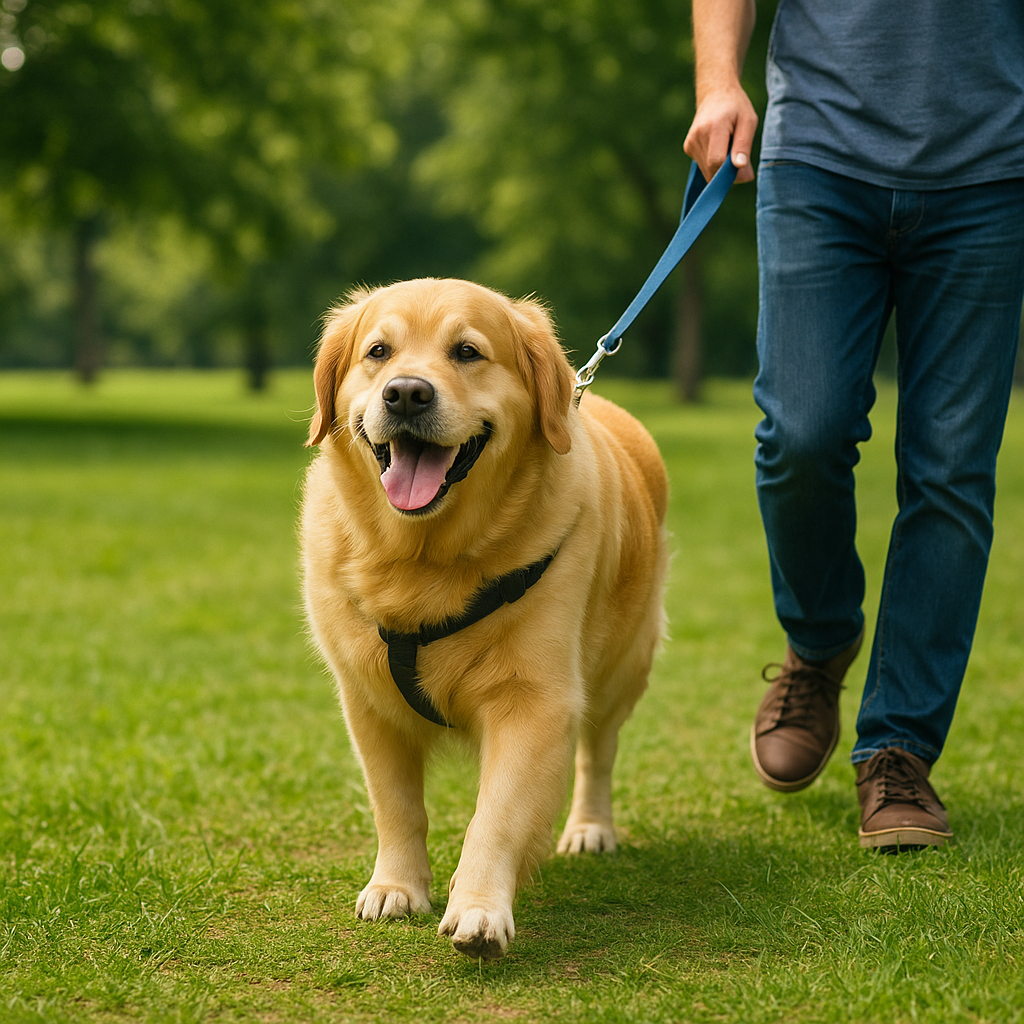
3. Use Targeted Calming Medications or Supplements
Dogs with noise phobia often benefit from calming aids, especially during firework season or thunderstorms. Medications should be prescribed by your vet and tailored to your dog’s health and level of fear.
Common options include:
- Dexmedetomidine gel (Sileo®) – FDA-approved for canine noise aversion
- Trazodone – Often used as a situational anti-anxiety med
- Gabapentin – Reduces anxiety and pain simultaneously
- SSRIs or TCAs – For long-term anxiety management
- Nutraceuticals – Zylkene, L-theanine, or calming chews may help mild cases
Some owners also ask about CBD. While early data is promising, the lack of regulation and inconsistent formulations mean you should use veterinary-specific brands only and discuss with your vet first.
4. Start Desensitization Training
Desensitization is one of the most effective tools for helping dogs with noise phobia. It involves slowly exposing your dog to the scary sound at a low, non-frightening volume, and gradually increasing it over time while pairing it with something positive—like treats or a game.
For example: Play low-volume thunder sounds from YouTube while feeding high-value snacks. As your dog relaxes, you can slowly increase the volume over weeks or months.
This technique, when paired with counterconditioning (changing your dog’s emotional response), has shown long-term success in multiple clinical studies (Bohrium Review).
5. Try Calming Tools and Wraps
Many dogs with noise phobia respond positively to calming aids that provide physical comfort or environmental stability. While not all are equally effective, they’re often worth trying in combination with behavior therapy.
Helpful tools may include:
- ThunderShirts or Anxiety Wraps: These provide gentle, constant pressure which can promote a sense of security—similar to swaddling a baby.
- Adaptil Diffusers or Sprays: Pheromone-based products that mimic the calming scent of a nursing mother dog.
- White noise machines or calming playlists: Helps mask sudden outdoor noises that might trigger panic.
- Crate covers and blackout curtains: Dimming the light and reducing visual stimuli helps some dogs relax.
While evidence is mixed, these tools are generally low-risk and can make a noticeable difference for mildly to moderately affected dogs with noise phobia (Barnside Vet Hospital).
6. Avoid Reinforcing Fearful Reactions
It’s natural to want to soothe your dog when they’re scared—but dogs with noise phobia can sometimes interpret extra attention as reinforcement of their fear. This doesn’t mean you should ignore them; rather, stay calm and neutral, and reward only calm behaviors.
Avoid: Over-petting, panicking, or fussing
Do: Provide quiet presence, redirect with a toy, reward relaxed body language
Teaching your dog to associate noise with calm, predictable outcomes helps build emotional resilience over time.
7. Work With a Certified Trainer or Behaviorist
If your dog’s reactions are intense, dangerous, or worsening despite your best efforts, it’s time to consult a certified trainer or veterinary behaviorist. Dogs with noise phobia often need a tailored, gradual plan built on real-time feedback and behavioral science.
What a professional can offer:
- A personalized desensitization and counterconditioning plan
- Real-time coaching on reading your dog’s subtle cues
- Guidance on medication use and adjustments
- Tools to prevent generalization (e.g., fear of simiar sounds)
Look for certifications like CCPDT, IAABC, or Diplomate ACVB to ensure you’re working with a qualified expert.
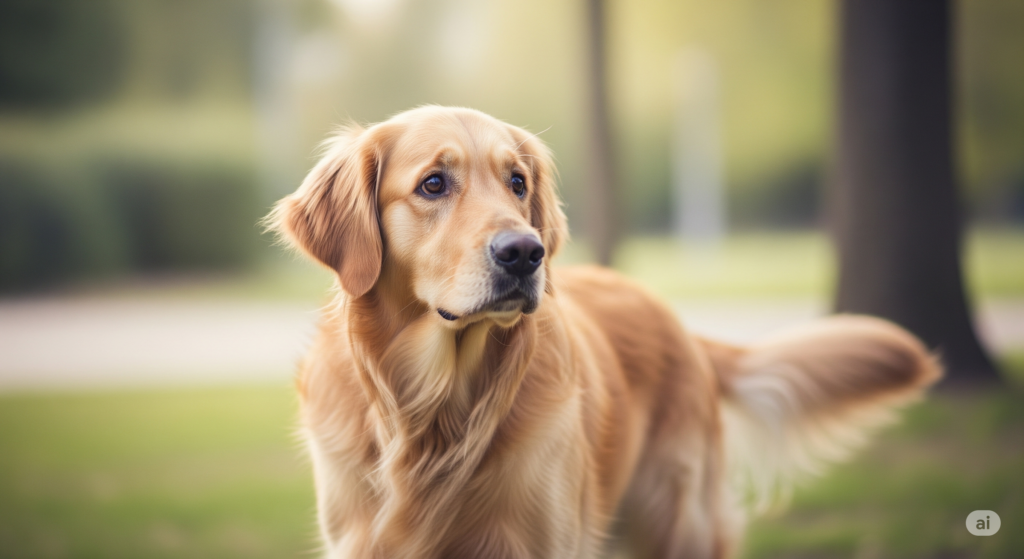
In one memorable case, a behaviorist helped a Golden Retriever with severe fireworks phobia by combining sound therapy, relaxation cues, and daily anxiety meds. After six months, the dog no longer panicked when New Year’s Eve rolled around.
Typical Treatment Costs in Canada
Supporting dogs with noise phobia often involves a mix of veterinary care, behavioral training, and at-home tools. Here’s a breakdown of what pet owners in Canada might expect to pay:
| Service or Product | Estimated Cost (CAD) |
|---|---|
| Initial veterinary consultation | $100–$250 |
| Behaviorist consultation (1–2 hours) | $300–$600 |
| Prescription medications (monthly) | $30–$120 |
| Calming supplements/tools | $20–$100 |
| ThunderShirt or wrap | $50–$80 |
| Sound desensitization apps/videos | Free–$50 |
| Follow-up training sessions | $75–$150 per session |
Keep in mind that not all dogs with noise phobia require every option on this list. Many dogs improve significantly with just a few strategic changes guided by your veterinarian.
Prevention Tips for Puppies
Preventing dogs with noise phobia starts early—ideally during the puppy’s sensitive socialization window (between 3 and 14 weeks of age). Positive, controlled exposure to a wide range of sounds can help your dog grow up more resilient to life’s noisy moments.
How to build sound confidence:
- Introduce sounds gradually: Play recordings of thunder, vacuum cleaners, or sirens at low volume while giving treats or playing.
- Pair sounds with positive outcomes: Feed your pup, play a game, or cuddle when unfamiliar noises happen.
- Stay calm: Your dog mirrors your reactions. Avoid fussing if they look startled; carry on like nothing happened.
- Socialize in real-life settings: Let your pup explore busy streets, parks, and stores where they’ll hear real-world sounds.
Well-socialized puppies are far less likely to become dogs with noise phobia later in life (Your Dog Advisor).
FAQ: Common Questions About Dogs With Noise Phobia
1. Can dogs with noise phobia be cured?
While not always “curable,” most dogs with noise phobia can significantly improve with proper treatment. Many reach a point where they stay calm or mildly reactive during triggering events.
2. Are certain breeds more prone to noise phobia?
Yes. Herding breeds (like Border Collies and Australian Shepherds), working breeds, and some terriers tend to be more noise-sensitive due to their high alertness and responsiveness to stimuli.
3. Is long-term medication safe?
Most medications used for managing dogs with noise phobia, including SSRIs and trazodone, are safe when prescribed and monitored by a veterinarian.
4. How can I tell if my dog’s fear is linked to pain?
If your dog shows sudden onset of fear, resists handling, or reacts to being touched near joints or muscles, pain may be involved. A veterinary exam is essential.
5. Can calming treats or CBD help?
Mild cases may respond to calming chews or veterinary-formulated CBD, but these should not replace behavioral therapy or vet-prescribed medication for moderate to severe phobia.
6. How long does desensitization take?
It varies. Some dogs with noise phobia improve within weeks; others may need several months. Consistency and patience are key.

